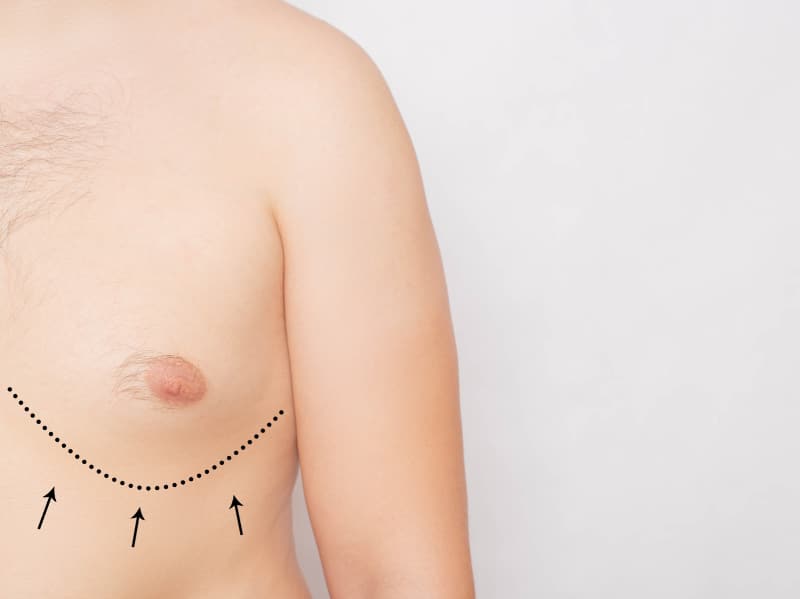Most people think that only women are worried about the size and appearance of their breasts, which is why they have breast augmentations and breast lifts.
However, some men have problems with enlarged breasts, also known as gynecomastia.
This issue is often a source of considerable embarrassment for men. The number of men who have opted for gynecomastia treatment surgery has risen over the past several years.
During puberty, changes in hormones can cause the male breast tissue to get larger. In some cases, the breast tissue shrinks when puberty is over. But sometimes, the breast enlargement remains, this can be considered pubertal gynecomastia and it is this breast enlargement that leads to unhappiness among men. Breast tissue growth and enlargement in the glandular tissue is often thought to be one of the most frustrating issues men have to address when it comes to their bodies.
It is estimated that the prevalence of asymptomatic gynecomastia is as much as 90% in children, 60% in adolescents, and 70% in men from 50 to 69.
Some of the most common causes of this condition are:
- Puberty (pubertal gynecomastia)
- Gaining too much weight
- Use of anabolic steroids
- Smoking marijuana
- Other medications also are known to cause male breast enlargement
How To Know If You Have Gynecomastia
Male breast enlargement usually happens in both male breasts, but some patients can have asymmetric breasts. A patient with gynecomastia may feel a disk-like mound of tissue in the breast that isn’t as hard as a breast cancer tumor in a self-exam. It’s located under the nipple area.
However, if a palpable mass in the male breast is unilateral, fixed, rigid, and peripheral to the nipple with enlarged lymph nodes and nipple discharge, male breast cancer could be the culprit. You should have your breasts examined by a doctor and possibly have an MRI or mammogram.
Gynecomastia Treatment
When a patient goes to a surgeon and expresses dissatisfaction about enlarged male breasts, the surgeon will assess what kind of tissue is causing enlargement. Surgery to take out the tissue usually involves liposuction of the excess fat.
Gynecomastia is more than a fat problem. Your surgeon may remove extra glandular breast tissue via an incision around the nipple. Your plastic surgeon also must do a complete physical examination of the breasts to confirm the condition and rule out breast cancer.
To prepare for this surgery, you should stop taking any prescription or over-the-counter drugs that boost the chances of bleeding. Also, please stop smoking for several weeks before the operation, and eat a healthy diet to encourage proper gynecomastia recovery and healing.
Most plastic surgeons do this procedure under general anesthesia, but it’s possible to do it with oral sedation and local anesthesia. Your surgeon may put in drains after the procedure to reduce the chances of fluid buildup.
It also helps to use a compression vest and ice to reduce swelling, bruising, and pain.
When patients choose to have liposuction, excision, or a combination, the results of this surgery are usually excellent and permanent. However, if the condition was caused by prescription drugs, illicit drugs, or weight gain, the patient will need to keep a healthy lifestyle to maintain the results.
Gynecomastia Surgery Recovery
If you only need liposuction to correct your condition, you can get back to work and exercise in less than a week. If you need to have excess breast tissue removed, it can take up to four weeks before engaging in regular activities.
Many patients say they can go back to work after seven to 10 days and can engage in cardio exercise after two weeks. It’s important not to overdo your activities in the first week or so; that way, your incisions have time to heal.
Gynecomastia Surgery Complications
This procedure is safe, and most patients enjoy a fast recovery. Even though your surgeon will pay great attention to safety, occasional complications arise. Some of the most common issues after this procedure are:
- Bruising
- Bleeding
- Fluid collections
- Contour irregularities
- Loss of skin in the nipple
- Scarring
- Inverted nipples
- Loose breast skin
You can avoid most complications by following your surgeon’s instructions for your recovery. Many complications arise because patients don’t follow their doctor’s instructions after the procedure.
Who Is A Candidate For Gynecomastia Surgery?

The other is caused by gaining weight and extra fat stored in the chest. This can cause more blood flow to the area and higher estrogen production. Also, using steroids and some antidepressants, and hormonal therapies can increase your muscle mass, making your estrogen levels rise. This may lead to the growth of unwanted breast tissue.
A Mayo Clinic study found that 50% or 60% of adolescent males may have this issue with breast growth, but the swelling and tissue size usually recedes with age.
If you have a BMI between 19 and 30, are healthy, and a stable body weight, you could be a good candidate for this procedure.
Non-Surgical Options For Gynecomastia
Non-invasive treatments for gynecomastia are not as effective as surgery, but new clinical studies show that some drug therapies can help with the problem. They are:
- Androgens, such as testosterone, danazol, and dihydrotestosterone
- Anti-estrogens, such as clomiphene citrate and tamoxifen
- Aromatase inhibitors, such as letrozole and anastrozole
Some doctors report that some patients with gynecomastia may benefit from testosterone treatments if they have a low hormone level. There is a relationship between a luteinizing hormone and gynecomastia. Also, danazol, which is a synthetic type of testosterone that reduces estrogen production, can be helpful. Liposuction in some cases can reduce fatty deposits.
However, before you try prescription drugs for this condition, it’s wise to eliminate any lifestyle issues contributing to gynecomastia.
This means you should get to a healthy body weight as soon as possible. Also, stop taking medications or illicit drugs that cause the issue and treat any underlying systemic condition.
Questions and Answers
How else can gynecomastia develop?
It is also possible for prostate cancer patients to develop gynecomastia in one or both breasts. When men have prostate cancer they undergo prostate cancer treatment which involves receiving antiandrogen, this can lead to breast swelling and idiopathic gynecomastia.
Is gynecomastia a sign of anything else?
Often, gynecomastia is isolated but sometimes it can be an indication of a testicular tumor.
Is there a gynecomastia cure?
While there is no total cure for gynecomastia, gynecomastia surgery is concerned permanent in most cases and is able to address this problem directly and effectively for many men.
What is the best treatment for gynecomastia?
Severe gynecomastia in boys causing discomfort or embarrassment may be treated with a brief course of tamoxifen (e.g., Nolvadex) or raloxifene (e.g., Evista). These medications inhibit estrogen effects, helping reduce breast size.
How can I make gynecomastia go away quickly?
Effective Gynecomastia Reduction Exercises. Spot reduction isn’t feasible, so focus on cardio for overall fat loss and chest exercises to enhance pectoral muscle tone and minimize gynecomastia appearance.
Request a Gynecomastia Consultation
Interested in a gynecomastia procedure in Houston? Wondering about gynecomastia surgery cost? Please set up a consultation with Dr. Ashley Steinberg – Trouvaille Aesthetics & Plastic Surgery today. She’ll talk to you about the benefits and risks of the procedure to determine if you’re a good candidate for a gynecomastia procedure.
References
Everything You Need To Know About Man Boobs. (2019). Accessed at https://www.medicalnewstoday.com/articles/326637
Enlarged Breasts In Men – Gynecomastia. (n.d.). Accessed at https://www.mayoclinic.org/diseases-conditions/gynecomastia/diagnosis-treatment/drc-20351799
What Men Need To Know Before Having Gynecomastia Surgery. (2019). Accessed at https://www.plasticsurgery.org/news/blog/what-men-need-to-know-before-having-gynecomastia-surgery













